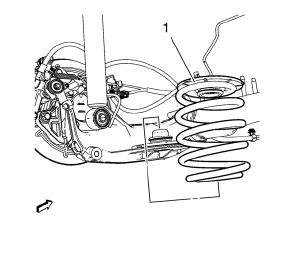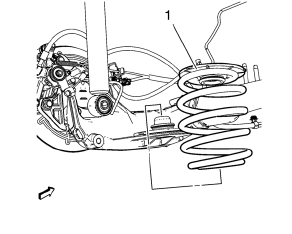Chevrolet Cruze Repair Manual: Rear Spring Replacement
Removal Procedure
- Raise and suitably support the vehicle. Refer to Lifting and Jacking the Vehicle.
- Support the rear axle with a tall jack stand near the shock absorber.
- Remove the lower shock bolt. Refer to Shock Absorber Replacement.
- Using the tall jack stands, slowly lower the rear axle in order to remove tension from the rear springs.

- Remove the spring (1).

- Remove the upper spring seat/jounce bumper (1) from the spring, while leaving the lower spring seat on the axle.
Installation Procedure

- Install the upper spring seat/jounce bumper (1) on the spring.

- Install the spring (1) making sure the lower coil is seated into the lower spring seat.
- Using the jack stands, raise the rear axle in order to compress the rear springs.
- Install the lower shock absorber bolts. Refer to Shock Absorber Replacement.
- Lower the vehicle.
 Rear Spring Insulator Replacement
Rear Spring Insulator Replacement
Removal Procedure
Raise and suitably support the vehicle. Refer to Lifting and Jacking the
Vehicle.
Support the rear axle with a tall jack stand near the shock absorber.
Remove the lower sh ...
 Rear Axle Replacement
Rear Axle Replacement
Special Tools
EN 45059 Torque Angle Sensor Kit
For equivalent regional tools, refer to Special Tools.
Removal Procedure
Raise and suitably support the vehicle. Refer to Lifting and ...
Other materials:
Removal Procedure
Warning: Refer to Approved Equipment for Collision Repair Warning in the
Preface section.
Warning: Refer to Collision Sectioning Warning in the Preface section.
Warning: Refer to Glass and Sheet Metal Handling Warning in the Preface section.
Disable the SIR System. Refer to SIR Dis ...
Lap-Shoulder Belt
All seating positions in the vehicle have a lap-shoulder belt.
The following instructions explain how to wear a lap-shoulder belt properly.
1. Adjust the seat, if the seat is adjustable, so you can sit up straight. To
see how, see “Seats” in the Index.
2. Pick up the latch plate and pull the ...
Installation Procedure
Cut the rocker outer panel in corresponding locations to fit the
remaining original panel. The sectioning joint should be trimmed to
allow a gap of one-and-one-half-times the metal thickness at the sectioning
joint.
Create a 50 mm (2 in) backing plate from the unused portion of the ...
